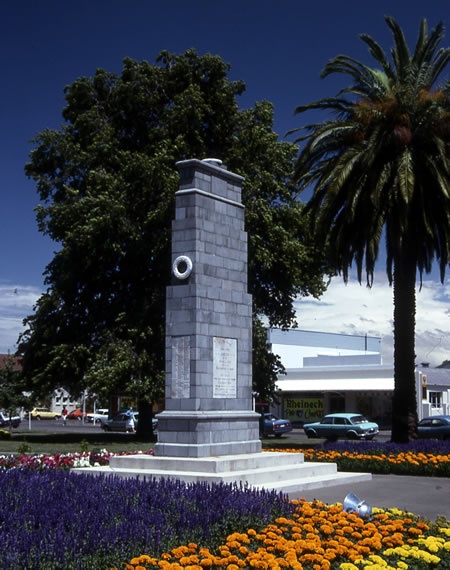
The Hawke’s Bay Fallen Soldiers’ Memorial, c.1986.
The Cenotaph in Hastings’ Civic Square is a solemn tribute to, and a commemoration of, the contribution of Hawke’s Bay soldiers who served and died during the First World War.
The sense of loss and grief from the First World War manifested itself in the building of hundreds of memorials in towns and cities all over the country, the memorials served as surrogate tombs for families of the soldiers buried in overseas graves, and commemorated the achievements of all those who lost their lives.
Hastings’ memorial was funded by the Hawke’s Bay Fallen Soldiers’ Memorial Committee, which also raised money for the Havelock North War Memorial dedicated on ANZAC Day 1925, and the Hawke’s Bay Fallen Soldiers’ Memorial Hospital opened on ANZAC Day 1928.
The Cenotaph, which means ‘empty tomb’ was the product of an agreement to erect a suitably imposing monument. The location of the monument was a difficult matter. The Memorial Committee determined that the proper place would be where it could be seen most often by the greatest number. It was impossible to erect it on Heretaunga Street, and with the consent of the Borough Council the site upon which it now stands was selected. It can be easily seen from the railway crossing; it is only a minute’s walk from the main street, and it is seen by everyone passing in the train. And although the site was not met with the approval of all, it was a wise selection and the best available at the time, which set the intention to form the Civic Square.
The site faced the extension of what was known as Station Street. This street was later renamed ‘Russell Street’ in honour of Major-General Sir Andrew Russell, who in 1923, was the national president of the RSA. Sir Andrew was a Hawke’s Bay sheep farmer and British-trained military officer who, after serving time at Gallipoli, became the commander of New Zealand forces on the western front. He was widely regarded as an inspirational military leader during battles when many New Zealanders died in action.
The selection of a design required much serious thought, and it was generally recognised that no matter what form it took it was impossible to please everybody. Much advice was sought and photographs of hundreds of designs were examined. Eventually, the Memorial Committee unanimously agreed that there be erected in Hastings an exact replica of the influential Cenotaph at Whitehall, London, designed by Sir Edward Luytens and completed in 1920. Unfortunately the funding was insufficient for a replica, and although the design remained the same, the memorial was reduced in width.
The Cenotaph is built of blue Coromandel tonalite, shot finished, with reinforced concrete foundations and core. Three laurel wreaths, similar to those on the London monument, are of white Italian marble. One is placed above each side tablet, and the third crowns the top of the monument. There are three tablets, also of Italian marble, one on each side, deeply inscribed with the names of Hawke’s Bay men who fell in the war, and one in front bearing the dedication.
The height of the Cenotaph is 7.31 metres, and its base is 4.87 metres deep, and together it weighs 86 tonnes. The whole of the work was executed by the Hawke’s Bay Monumental Works of Napier.
Over 2000 people gathered on the afternoon of Armistice Day, 11 November 1923 to witness the memorial being unveiled by the Mayoress Mrs G. A. Maddison and dedicated by the Parish Priest of St Matthew’s Church, Reverend R. T. Hall. Its full title is the Hawke’s Bay Fallen Soldiers Memorial.
Mr George Ebbett addressed the congregation saying: 'we have raised this monument as an everlasting tribute in honour and in memory of those who gave their lives. While I deplore it, and many will deplore it, I am satisfied that as time goes on we shall be inclined to forget what was done for us and what sacrifices were made for us during the war. The very freedom which we enjoy today, the liberty which we have reason to value so highly, are altogether entirely due to the sacrifice made by millions of men in order that these inestimable and invaluable privileges might be secured to us and to our children, we hope for ever.'
Following the unveiling Mr Ebbett, as chairperson of the Memorial Executive Committee, then formally handed the Cenotaph, over to the Mayor of Hastings in the following terms: 'The Committee of the Hawke’s Bay Fallen Soldiers’ Memorial Fund respectfully requests you to assume, on behalf of the citizens of Hastings, the control and guardianship of that portion of the Fallen Soldiers’ Memorial known as the Cenotaph, situated in Russell street, within your borough. May we express a fervent hope that you and your successors will faithfully and steadfastly fulfil this trust, and that you will keep and maintain this monument in safety, and you will fully appreciate the importance of preserving its sanctity, by every means in your power, so that it may remain as an everlasting memorial in honour of our dead for all time.'
The Mayor, in accepting the responsibility on behalf of the town, said: 'It is my privilege and sacred duty to accept in trust, on behalf of the citizens of Hastings and its administrators throughout the ages, the guardianship of this Cenotaph, as a sacred trust, and as the embodiment of love, self-sacrifice and duty.'






Community contributions